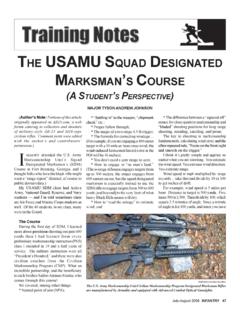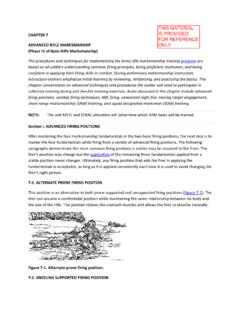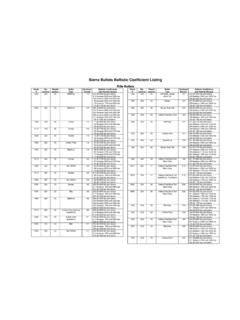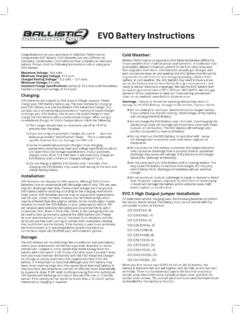Transcription of THIS MATERIAL IS PROVIDED FOR BACKGROUND …
1 Terminal Ballistic Performance of the Cartridge this MATERIAL IS PROVIDED FOR BACKGROUND REFERENCE ONLY Tactical Briefs (Volume 2, Number 6) June 1999 .223 Remington Ammunition for Personal Defense/Law Enforcement IWBA member Gary Roberts performed terminal performance testing of twenty-three different .223 Remington loads and published his results as follows: Roberts, GK: "The Wounding Effects of Law Enforcement General Purpose Shoulder Fired Carbines Compared With 12 Ga. Shotguns and Pistol Caliber Weapons using 10% Ordnance Gelatin as a Tissue Simulant." Wound ballistics Review, 3(4); Autumn 1998, and Roberts, GK: "Law Enforcement General Purpose Shoulder Fired Weapons -- The Wounding Effects of Carbines Compared With 12 Ga. Shotguns and Pistol Caliber Weapons using 10% Ordnance Gelatin as a Tissue Simulant." Police Marksman, July/August 1998. As a result of his testing, Roberts recommended nine cartridges.
2 Three of these cartridge recommendations are available only to law enforcement, whereas the remaining six are (or were) commercially available. We investigated the availability of these loads and offer the following commentary: Winchester Supreme Match 69gr JHPBT (S223M) was discontinued in 1998 and is no longer available. Federal 69gr JHP (223M) was tested and recommended by Roberts but we're unable to find any load under this product number in Federal's catalog. (We're unwilling to assume that the Federal .223 Remington 69gr JHP 223M cartridge, tested by Roberts, is the same as the currently available Gold Medal Match GM223M load.) Attempts to contact Roberts for clarification were unsuccessful. Federal 55gr Tactical JSP (LE223T1) is available to law enforcement agencies only. this bullet produces the least amount of tissue disruption of all the .223 cartridges recommended by Roberts. The bullet does not fragment very much.
3 Its performance is not much of an improvement over a .22 Long Rifle 40gr lead HP. Winchester 64gr JSP (Q3246 "Knurled") is a California Highway Patrol contract load which uses the 64gr Power-Point bullet with a cannelure. According to a Winchester spokesman, this load is also available to other law enforcement agencies upon request. The CHP specifies a cannelure to prevent bullet setback, and subsequent feeding failures, in its AR-15 rifles. Olin M855/Winchester 62gr FMJ (RA556M855) is from Winchester's Ranger line of law enforcement ammunition. Whether or not other manufacturer's M855/SS109-type ammunition delivers similar performance is unknown. Terminal Ballistic Performance of the Cartridge Black Hills 60gr JSP, 68 grain JHP and 75gr JHP are recommended by Roberts. We contacted Black Hills ammunition company and confirmed that the cartridges tested by Roberts used the same bullets as current production ammunition.
4 Olin M193/Winchester 55gr FMJ (X223R1) is recommended. this load is available as Winchester USA Q3131. Whether or not other manufacturer's M193-type ammunition delivers similar performance is unknown. Although Roberts tested Winchester's 64gr Power-Point JSP cartridge (X223R2), and found it acceptable, he did not specifically recommend its use in autoloading carbines and SMGs. There is no cannelure on the bullet, and Roberts alludes to feeding failures caused by bullet setback in the case mouth. In 1999 Winchester began offering a moly-coated 64gr Supreme Power-Point Plus load (SHV223R2), which develops slightly greater velocity than the 64gr Super-X Power-Point JSP load. Both the Supreme and Super-X loads use the same bullet. The critical minimum velocity for obtaining maximum terminal performance from .223 ammunition is approximately 2700 fps. Bullets that are propelled below this velocity do not provide optimal terminal performance, and thus are less capable of creating wound trauma that will produce rapid incapacitation of a criminal attacker.
5 RIFLE AMMUNITION The criteria for rifle ammunition is essentially the same as for handgun bullets, and many of the same design factors apply. One important difference for rifle ammunition is that the velocities are much higher, and the effect of the temporary cavity starts contributing quite a bit towards creating damage, especially as one moves up in caliber/velocity. There are expanding rifle bullets which will do the job just like for handguns, as well as fragmenting bullets. As previously discussed, the heavier bullets perform better here also. If a bullet fragments, there should be sufficient mass in the largest fragments to ensure penetration to the 12" level for optimum performance. this disqualifies many varmint bullets; while they show dramatic fragmentation, the fragments sometimes penetrate to only 6" or so. this creates impressive surface wounds, but may not penetrate deeply enough.
6 The is approximately the equal of a .30-30 rifle cartridge, but there are very few bullet designs which perform adequately unfortunately. For comparison, here are some pictures of how some military rifle bullets perform in ballistic gelatin: Terminal Ballistic Performance of the Cartridge Terminal Ballistic Performance of the Cartridge In the above diagram, the lines at 20cm and 30cm represent: 20cm (8"): The distance through a human torso in the ideal frontal torso shot. 30cm (12"): The minimum recommended penetration distance As is readily apparent, FMJ ammunition - in general - is a poor performer. It penetrates deeply, but neither expands nor fragments. The well-documented performance of the M855 as a fragmenting bullet in the diagrams above is an exception; the fragmentation contributes significantly to its performance. Please refer to the Ammo FAQ for further discussion.
7 You will note that M193/M855 are NOT on the recommended list below. If you want to know why, jump ahead to this link. Terminal Ballistic Performance of the Cartridge I'm omitting hunting rifle data, since I assume most people will not bother to use their lever-action rifles in a self-defense situation. Note about Barnes bullets: The TSX is being sold by Barnes as the TAC-X starting in 2009. There are no differences between the TSX and the TAC-X..223 While the M855-type ammunition generally meets performance requirements, there have been quite a few reports in inadequate fragmentation. Please remember that this is military ammo, and while the fragmenting properties are well documented and understood, there is no requirement for the bullet to fragment when being tested for acceptance. There can be significant variations in constructions which could make some lots perform much worse than others.
8 For this reason, it is not on the list. While the M193-type ammo is not nearly as complicated of a design, it is also not inherently as devastating as the heavier OTMs listed below. Since this article is about the BEST choices for self-defense ammunition, it is omitted also. As far as ammunition choices listed below are concerned, keep in mind that some manufacturers might offer the same bullet loaded to .223 chamber pressures and also at chamber pressures. The latter allow for approximately 100-200fps more velocity and subsequent better performance. this is the case for the Hornady TAP ammo. An excellent article written by Molon shows the performance of various types of heavy OTMs, including all the Hornady TAP variations and Mk262 77gr OTM ammunition, velocities, accuracy, etc. It is one of the most comprehensive on the subject I have ever seen and will pretty much tell you anything you need to know.
9 CLICK HERE TO READ THAT ARTICLE. Included in the article are comparisons of pretty much all components that make up this ammo, including reports of the type of bullet used, the type of powder, primers, velocities through different barrel lengths, accuracy, etc. It also includes pictures of shots into ballistic gelatin of 40/55/75gr TAP, as well as some 77gr loads. Your rifle's twist rate plays a large part in choosing the right bullet. The most common twist rate is 1:9, and it should (make sure you test it to be sure) stabilize 75gr bullets, and some even work with 77's. 1:7's can use any bullet listed. If you're stuck with 1:12, your choices are narrowed down significantly. Summarizing Doctor Roberts' choices results in the following list: If Barrier penetration is NOT an important factor AND your rifle can stabilize them (1:9 minimum twist rate): Terminal Ballistic Performance of the Cartridge Hornady 75gr OTM loads Nosler 77gr OTM loads Sierra 77gr SMK loads If Barrier penetration is NOT an important factor AND your rifle can't stabilize the heavy 70+ grain bullets: Sierra 69gr SMK loads Hornady 68gr OTM loads Winchester 64gr JSP (RA223R2) Federal 64gr TRU (223L) Hornady 60gr JSP If your rifle is 1:12 twist rate and can only shoot lighter-weight bullets: 55gr Federal bonded JSP load (LE223T1 or P223T2) Barnes 55gr TSX/TAC-X 50gr TSX loaded by Black Hills* If Barrier penetration IS an important factor (most of these should work with 1.)
10 9 barrels, but use common sense in regards to twist rate requirements) 62gr Federal Trophy Bonded Bear Claw (TBBC) bonded JSP (XM556 FBIT3)* 64gr Winchester solid base bonded JSP (Q3313/RA556B)* 50gr TSX loaded by Black Hills* Speer 55 & 64gr Gold Dot JSP ( )* Federal 62gr Mk318 Mod0 (T556 TNB1)* 62gr Federal bonded JSP Tactical (LE223T3) 55gr Federal bonded JSP load (Tactical LE223T1 or identical Premium Rifle P223T2) Swift 75gr Scirocco (usually requires 1:7 twist) 60gr Nosler Partition JSP Remington 62gr bonded JSP Terminal Ballistic Performance of the Cartridge Federal 55gr TSX (T223S) Speer 55 & 64gr Gold Dot JSP (.223) Federal 62gr Fusion JSP (Same construction as the Gold Dot) Loads marked with * are loads and indicate preferred loadings. CLICK HERE FOR GELATIN PERFORMANCE RESULTS OF SOME OF THE AFOREMENTIONED BARRIER LOADS. If using a short-barreled weapon: The same guidelines apply as for barrier penetration loads.












